International Marketing Case: LEGO & JWT in the Chinese Market
VerifiedAdded on 2023/06/12
|17
|5537
|205
Case Study
AI Summary
This case study examines the international marketing strategies of LEGO and JWT in the Chinese market, identifying key success factors for foreign-owned companies. It delves into the Chinese business environment, emphasizing the importance of market research, understanding the complex legal environment, and finding the right local partners. The analysis covers major macroeconomic indicators, FDI trends, and investment opportunities in China. Furthermore, the study highlights the qualities a CEO needs to excel in the Chinese market, such as adaptability, persistence, and a people-centric leadership style. The report concludes with recommendations for foreign firms seeking to tap into China's new national policies, providing insights for strategic direction and business sustainability. Desklib provides access to similar case studies and study resources for students.
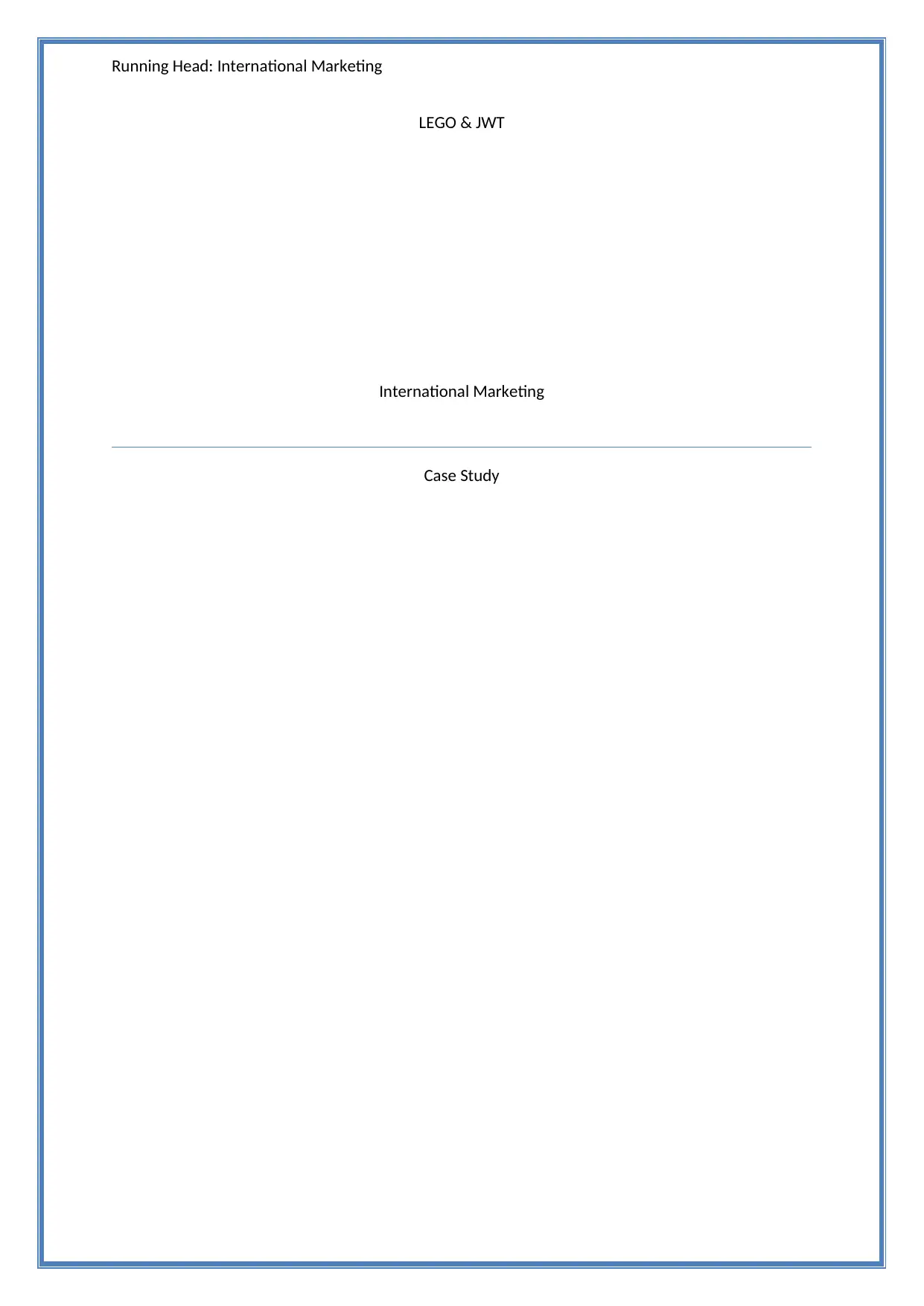
Running Head: International Marketing
LEGO & JWT
International Marketing
Case Study
LEGO & JWT
International Marketing
Case Study
Paraphrase This Document
Need a fresh take? Get an instant paraphrase of this document with our AI Paraphraser
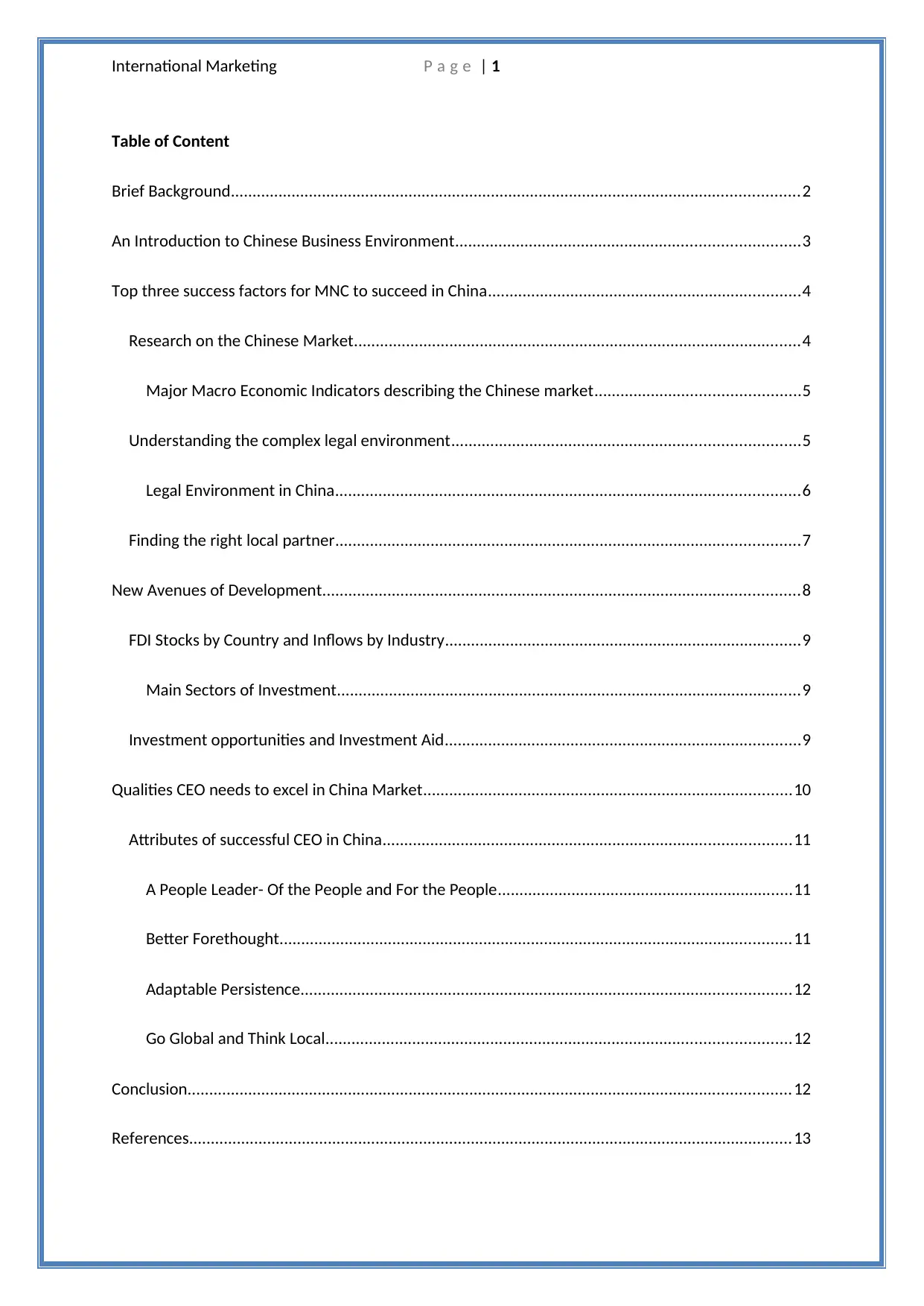
International Marketing P a g e | 1
Table of Content
Brief Background...................................................................................................................................2
An Introduction to Chinese Business Environment...............................................................................3
Top three success factors for MNC to succeed in China........................................................................4
Research on the Chinese Market.......................................................................................................4
Major Macro Economic Indicators describing the Chinese market...............................................5
Understanding the complex legal environment................................................................................5
Legal Environment in China...........................................................................................................6
Finding the right local partner...........................................................................................................7
New Avenues of Development..............................................................................................................8
FDI Stocks by Country and Inflows by Industry..................................................................................9
Main Sectors of Investment...........................................................................................................9
Investment opportunities and Investment Aid..................................................................................9
Qualities CEO needs to excel in China Market.....................................................................................10
Attributes of successful CEO in China..............................................................................................11
A People Leader- Of the People and For the People....................................................................11
Better Forethought......................................................................................................................11
Adaptable Persistence.................................................................................................................12
Go Global and Think Local...........................................................................................................12
Conclusion...........................................................................................................................................12
References...........................................................................................................................................13
Table of Content
Brief Background...................................................................................................................................2
An Introduction to Chinese Business Environment...............................................................................3
Top three success factors for MNC to succeed in China........................................................................4
Research on the Chinese Market.......................................................................................................4
Major Macro Economic Indicators describing the Chinese market...............................................5
Understanding the complex legal environment................................................................................5
Legal Environment in China...........................................................................................................6
Finding the right local partner...........................................................................................................7
New Avenues of Development..............................................................................................................8
FDI Stocks by Country and Inflows by Industry..................................................................................9
Main Sectors of Investment...........................................................................................................9
Investment opportunities and Investment Aid..................................................................................9
Qualities CEO needs to excel in China Market.....................................................................................10
Attributes of successful CEO in China..............................................................................................11
A People Leader- Of the People and For the People....................................................................11
Better Forethought......................................................................................................................11
Adaptable Persistence.................................................................................................................12
Go Global and Think Local...........................................................................................................12
Conclusion...........................................................................................................................................12
References...........................................................................................................................................13

International Marketing P a g e | 2
⊘ This is a preview!⊘
Do you want full access?
Subscribe today to unlock all pages.

Trusted by 1+ million students worldwide
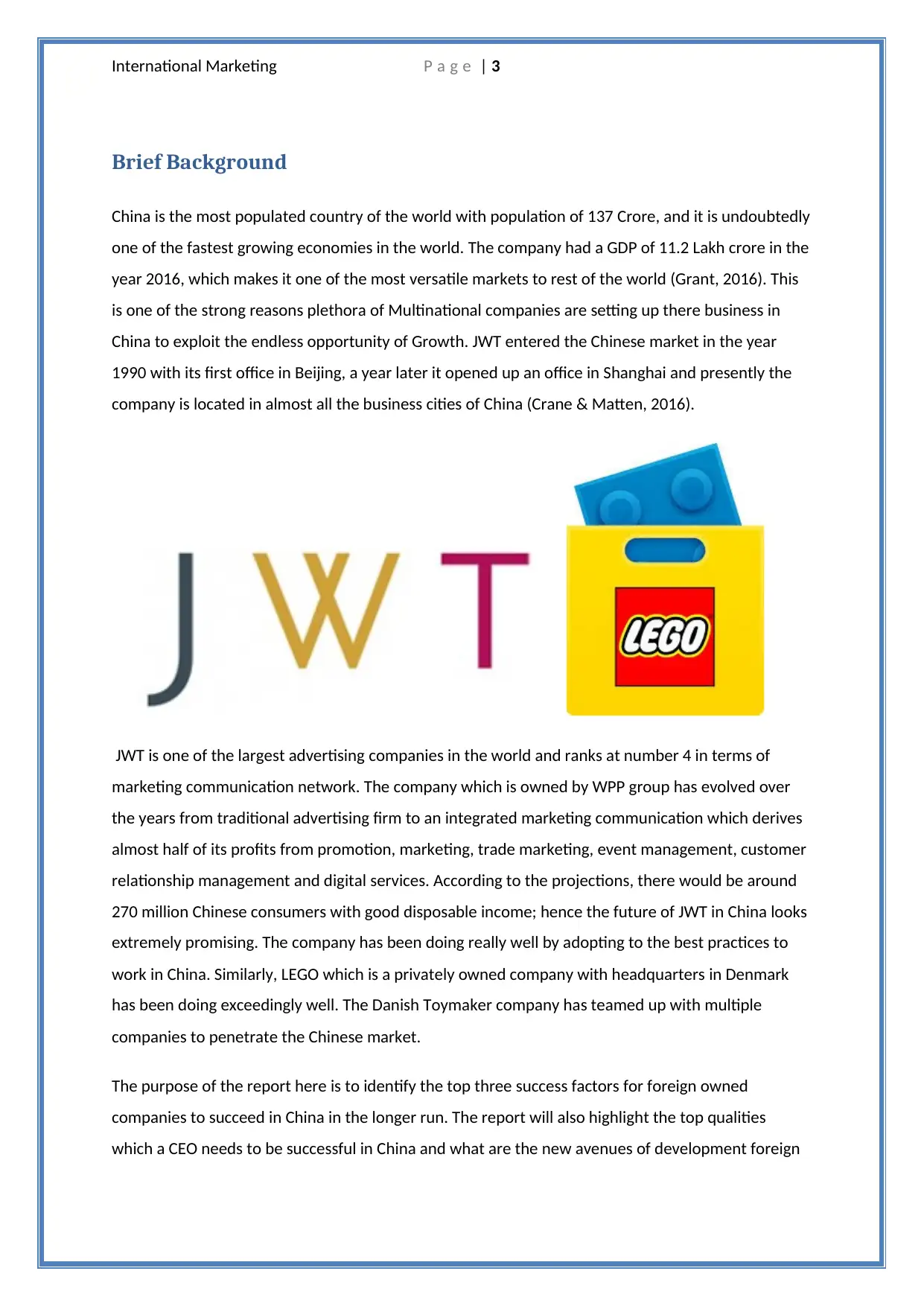
International Marketing P a g e | 3
Brief Background
China is the most populated country of the world with population of 137 Crore, and it is undoubtedly
one of the fastest growing economies in the world. The company had a GDP of 11.2 Lakh crore in the
year 2016, which makes it one of the most versatile markets to rest of the world (Grant, 2016). This
is one of the strong reasons plethora of Multinational companies are setting up there business in
China to exploit the endless opportunity of Growth. JWT entered the Chinese market in the year
1990 with its first office in Beijing, a year later it opened up an office in Shanghai and presently the
company is located in almost all the business cities of China (Crane & Matten, 2016).
JWT is one of the largest advertising companies in the world and ranks at number 4 in terms of
marketing communication network. The company which is owned by WPP group has evolved over
the years from traditional advertising firm to an integrated marketing communication which derives
almost half of its profits from promotion, marketing, trade marketing, event management, customer
relationship management and digital services. According to the projections, there would be around
270 million Chinese consumers with good disposable income; hence the future of JWT in China looks
extremely promising. The company has been doing really well by adopting to the best practices to
work in China. Similarly, LEGO which is a privately owned company with headquarters in Denmark
has been doing exceedingly well. The Danish Toymaker company has teamed up with multiple
companies to penetrate the Chinese market.
The purpose of the report here is to identify the top three success factors for foreign owned
companies to succeed in China in the longer run. The report will also highlight the top qualities
which a CEO needs to be successful in China and what are the new avenues of development foreign
Brief Background
China is the most populated country of the world with population of 137 Crore, and it is undoubtedly
one of the fastest growing economies in the world. The company had a GDP of 11.2 Lakh crore in the
year 2016, which makes it one of the most versatile markets to rest of the world (Grant, 2016). This
is one of the strong reasons plethora of Multinational companies are setting up there business in
China to exploit the endless opportunity of Growth. JWT entered the Chinese market in the year
1990 with its first office in Beijing, a year later it opened up an office in Shanghai and presently the
company is located in almost all the business cities of China (Crane & Matten, 2016).
JWT is one of the largest advertising companies in the world and ranks at number 4 in terms of
marketing communication network. The company which is owned by WPP group has evolved over
the years from traditional advertising firm to an integrated marketing communication which derives
almost half of its profits from promotion, marketing, trade marketing, event management, customer
relationship management and digital services. According to the projections, there would be around
270 million Chinese consumers with good disposable income; hence the future of JWT in China looks
extremely promising. The company has been doing really well by adopting to the best practices to
work in China. Similarly, LEGO which is a privately owned company with headquarters in Denmark
has been doing exceedingly well. The Danish Toymaker company has teamed up with multiple
companies to penetrate the Chinese market.
The purpose of the report here is to identify the top three success factors for foreign owned
companies to succeed in China in the longer run. The report will also highlight the top qualities
which a CEO needs to be successful in China and what are the new avenues of development foreign
Paraphrase This Document
Need a fresh take? Get an instant paraphrase of this document with our AI Paraphraser
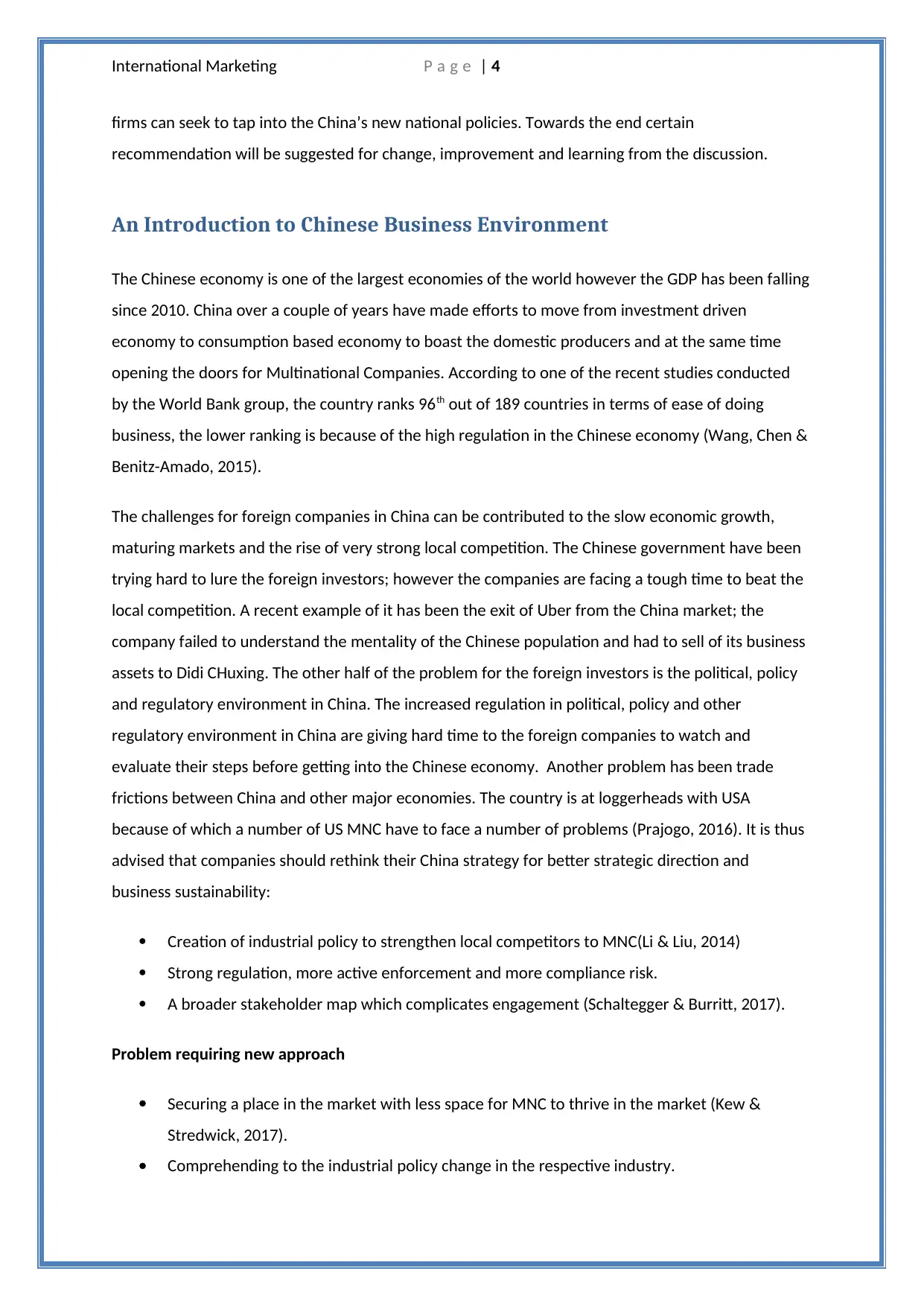
International Marketing P a g e | 4
firms can seek to tap into the China’s new national policies. Towards the end certain
recommendation will be suggested for change, improvement and learning from the discussion.
An Introduction to Chinese Business Environment
The Chinese economy is one of the largest economies of the world however the GDP has been falling
since 2010. China over a couple of years have made efforts to move from investment driven
economy to consumption based economy to boast the domestic producers and at the same time
opening the doors for Multinational Companies. According to one of the recent studies conducted
by the World Bank group, the country ranks 96th out of 189 countries in terms of ease of doing
business, the lower ranking is because of the high regulation in the Chinese economy (Wang, Chen &
Benitz-Amado, 2015).
The challenges for foreign companies in China can be contributed to the slow economic growth,
maturing markets and the rise of very strong local competition. The Chinese government have been
trying hard to lure the foreign investors; however the companies are facing a tough time to beat the
local competition. A recent example of it has been the exit of Uber from the China market; the
company failed to understand the mentality of the Chinese population and had to sell of its business
assets to Didi CHuxing. The other half of the problem for the foreign investors is the political, policy
and regulatory environment in China. The increased regulation in political, policy and other
regulatory environment in China are giving hard time to the foreign companies to watch and
evaluate their steps before getting into the Chinese economy. Another problem has been trade
frictions between China and other major economies. The country is at loggerheads with USA
because of which a number of US MNC have to face a number of problems (Prajogo, 2016). It is thus
advised that companies should rethink their China strategy for better strategic direction and
business sustainability:
Creation of industrial policy to strengthen local competitors to MNC(Li & Liu, 2014)
Strong regulation, more active enforcement and more compliance risk.
A broader stakeholder map which complicates engagement (Schaltegger & Burritt, 2017).
Problem requiring new approach
Securing a place in the market with less space for MNC to thrive in the market (Kew &
Stredwick, 2017).
Comprehending to the industrial policy change in the respective industry.
firms can seek to tap into the China’s new national policies. Towards the end certain
recommendation will be suggested for change, improvement and learning from the discussion.
An Introduction to Chinese Business Environment
The Chinese economy is one of the largest economies of the world however the GDP has been falling
since 2010. China over a couple of years have made efforts to move from investment driven
economy to consumption based economy to boast the domestic producers and at the same time
opening the doors for Multinational Companies. According to one of the recent studies conducted
by the World Bank group, the country ranks 96th out of 189 countries in terms of ease of doing
business, the lower ranking is because of the high regulation in the Chinese economy (Wang, Chen &
Benitz-Amado, 2015).
The challenges for foreign companies in China can be contributed to the slow economic growth,
maturing markets and the rise of very strong local competition. The Chinese government have been
trying hard to lure the foreign investors; however the companies are facing a tough time to beat the
local competition. A recent example of it has been the exit of Uber from the China market; the
company failed to understand the mentality of the Chinese population and had to sell of its business
assets to Didi CHuxing. The other half of the problem for the foreign investors is the political, policy
and regulatory environment in China. The increased regulation in political, policy and other
regulatory environment in China are giving hard time to the foreign companies to watch and
evaluate their steps before getting into the Chinese economy. Another problem has been trade
frictions between China and other major economies. The country is at loggerheads with USA
because of which a number of US MNC have to face a number of problems (Prajogo, 2016). It is thus
advised that companies should rethink their China strategy for better strategic direction and
business sustainability:
Creation of industrial policy to strengthen local competitors to MNC(Li & Liu, 2014)
Strong regulation, more active enforcement and more compliance risk.
A broader stakeholder map which complicates engagement (Schaltegger & Burritt, 2017).
Problem requiring new approach
Securing a place in the market with less space for MNC to thrive in the market (Kew &
Stredwick, 2017).
Comprehending to the industrial policy change in the respective industry.
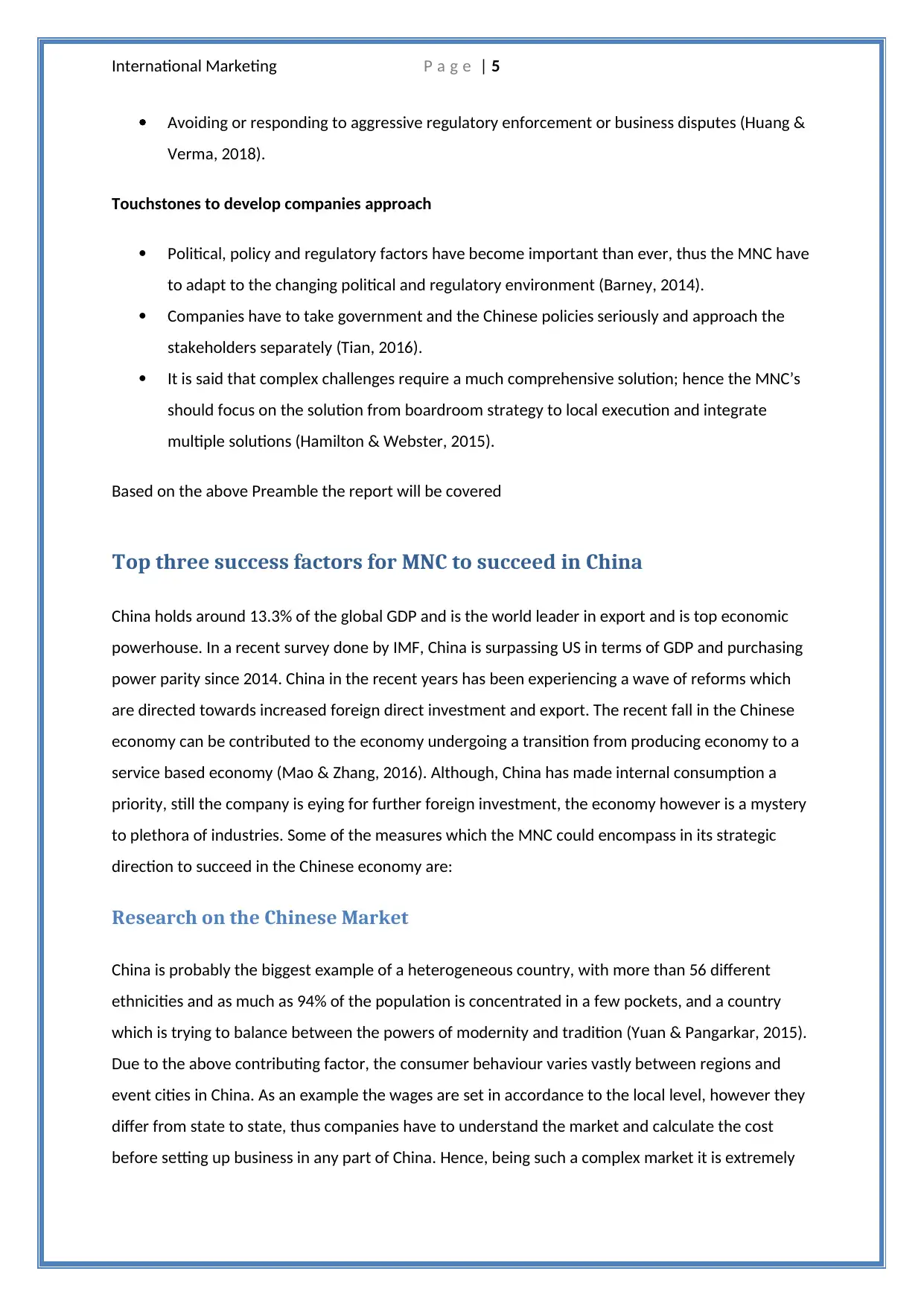
International Marketing P a g e | 5
Avoiding or responding to aggressive regulatory enforcement or business disputes (Huang &
Verma, 2018).
Touchstones to develop companies approach
Political, policy and regulatory factors have become important than ever, thus the MNC have
to adapt to the changing political and regulatory environment (Barney, 2014).
Companies have to take government and the Chinese policies seriously and approach the
stakeholders separately (Tian, 2016).
It is said that complex challenges require a much comprehensive solution; hence the MNC’s
should focus on the solution from boardroom strategy to local execution and integrate
multiple solutions (Hamilton & Webster, 2015).
Based on the above Preamble the report will be covered
Top three success factors for MNC to succeed in China
China holds around 13.3% of the global GDP and is the world leader in export and is top economic
powerhouse. In a recent survey done by IMF, China is surpassing US in terms of GDP and purchasing
power parity since 2014. China in the recent years has been experiencing a wave of reforms which
are directed towards increased foreign direct investment and export. The recent fall in the Chinese
economy can be contributed to the economy undergoing a transition from producing economy to a
service based economy (Mao & Zhang, 2016). Although, China has made internal consumption a
priority, still the company is eying for further foreign investment, the economy however is a mystery
to plethora of industries. Some of the measures which the MNC could encompass in its strategic
direction to succeed in the Chinese economy are:
Research on the Chinese Market
China is probably the biggest example of a heterogeneous country, with more than 56 different
ethnicities and as much as 94% of the population is concentrated in a few pockets, and a country
which is trying to balance between the powers of modernity and tradition (Yuan & Pangarkar, 2015).
Due to the above contributing factor, the consumer behaviour varies vastly between regions and
event cities in China. As an example the wages are set in accordance to the local level, however they
differ from state to state, thus companies have to understand the market and calculate the cost
before setting up business in any part of China. Hence, being such a complex market it is extremely
Avoiding or responding to aggressive regulatory enforcement or business disputes (Huang &
Verma, 2018).
Touchstones to develop companies approach
Political, policy and regulatory factors have become important than ever, thus the MNC have
to adapt to the changing political and regulatory environment (Barney, 2014).
Companies have to take government and the Chinese policies seriously and approach the
stakeholders separately (Tian, 2016).
It is said that complex challenges require a much comprehensive solution; hence the MNC’s
should focus on the solution from boardroom strategy to local execution and integrate
multiple solutions (Hamilton & Webster, 2015).
Based on the above Preamble the report will be covered
Top three success factors for MNC to succeed in China
China holds around 13.3% of the global GDP and is the world leader in export and is top economic
powerhouse. In a recent survey done by IMF, China is surpassing US in terms of GDP and purchasing
power parity since 2014. China in the recent years has been experiencing a wave of reforms which
are directed towards increased foreign direct investment and export. The recent fall in the Chinese
economy can be contributed to the economy undergoing a transition from producing economy to a
service based economy (Mao & Zhang, 2016). Although, China has made internal consumption a
priority, still the company is eying for further foreign investment, the economy however is a mystery
to plethora of industries. Some of the measures which the MNC could encompass in its strategic
direction to succeed in the Chinese economy are:
Research on the Chinese Market
China is probably the biggest example of a heterogeneous country, with more than 56 different
ethnicities and as much as 94% of the population is concentrated in a few pockets, and a country
which is trying to balance between the powers of modernity and tradition (Yuan & Pangarkar, 2015).
Due to the above contributing factor, the consumer behaviour varies vastly between regions and
event cities in China. As an example the wages are set in accordance to the local level, however they
differ from state to state, thus companies have to understand the market and calculate the cost
before setting up business in any part of China. Hence, being such a complex market it is extremely
⊘ This is a preview!⊘
Do you want full access?
Subscribe today to unlock all pages.

Trusted by 1+ million students worldwide
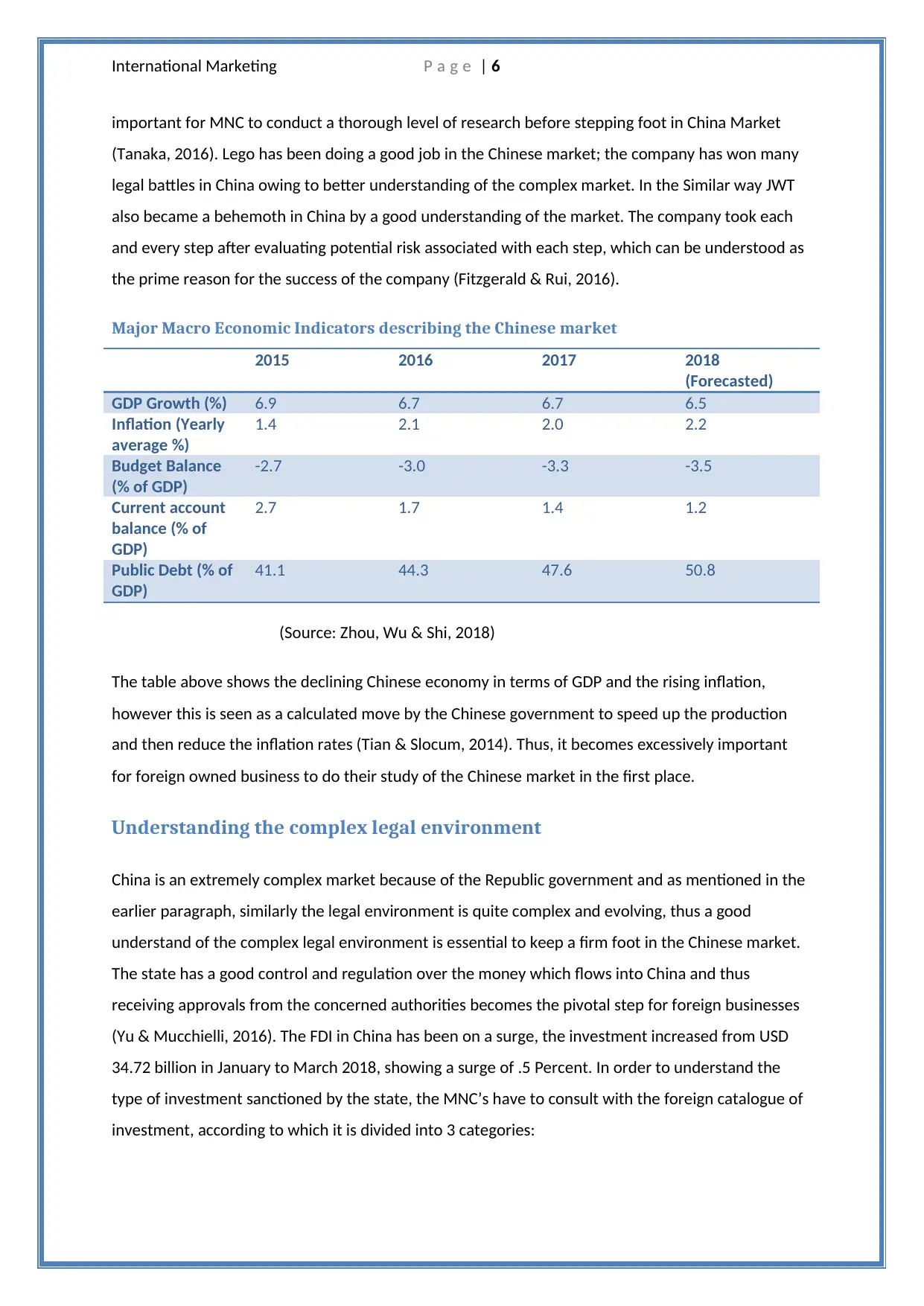
International Marketing P a g e | 6
important for MNC to conduct a thorough level of research before stepping foot in China Market
(Tanaka, 2016). Lego has been doing a good job in the Chinese market; the company has won many
legal battles in China owing to better understanding of the complex market. In the Similar way JWT
also became a behemoth in China by a good understanding of the market. The company took each
and every step after evaluating potential risk associated with each step, which can be understood as
the prime reason for the success of the company (Fitzgerald & Rui, 2016).
Major Macro Economic Indicators describing the Chinese market
2015 2016 2017 2018
(Forecasted)
GDP Growth (%) 6.9 6.7 6.7 6.5
Inflation (Yearly
average %)
1.4 2.1 2.0 2.2
Budget Balance
(% of GDP)
-2.7 -3.0 -3.3 -3.5
Current account
balance (% of
GDP)
2.7 1.7 1.4 1.2
Public Debt (% of
GDP)
41.1 44.3 47.6 50.8
(Source: Zhou, Wu & Shi, 2018)
The table above shows the declining Chinese economy in terms of GDP and the rising inflation,
however this is seen as a calculated move by the Chinese government to speed up the production
and then reduce the inflation rates (Tian & Slocum, 2014). Thus, it becomes excessively important
for foreign owned business to do their study of the Chinese market in the first place.
Understanding the complex legal environment
China is an extremely complex market because of the Republic government and as mentioned in the
earlier paragraph, similarly the legal environment is quite complex and evolving, thus a good
understand of the complex legal environment is essential to keep a firm foot in the Chinese market.
The state has a good control and regulation over the money which flows into China and thus
receiving approvals from the concerned authorities becomes the pivotal step for foreign businesses
(Yu & Mucchielli, 2016). The FDI in China has been on a surge, the investment increased from USD
34.72 billion in January to March 2018, showing a surge of .5 Percent. In order to understand the
type of investment sanctioned by the state, the MNC’s have to consult with the foreign catalogue of
investment, according to which it is divided into 3 categories:
important for MNC to conduct a thorough level of research before stepping foot in China Market
(Tanaka, 2016). Lego has been doing a good job in the Chinese market; the company has won many
legal battles in China owing to better understanding of the complex market. In the Similar way JWT
also became a behemoth in China by a good understanding of the market. The company took each
and every step after evaluating potential risk associated with each step, which can be understood as
the prime reason for the success of the company (Fitzgerald & Rui, 2016).
Major Macro Economic Indicators describing the Chinese market
2015 2016 2017 2018
(Forecasted)
GDP Growth (%) 6.9 6.7 6.7 6.5
Inflation (Yearly
average %)
1.4 2.1 2.0 2.2
Budget Balance
(% of GDP)
-2.7 -3.0 -3.3 -3.5
Current account
balance (% of
GDP)
2.7 1.7 1.4 1.2
Public Debt (% of
GDP)
41.1 44.3 47.6 50.8
(Source: Zhou, Wu & Shi, 2018)
The table above shows the declining Chinese economy in terms of GDP and the rising inflation,
however this is seen as a calculated move by the Chinese government to speed up the production
and then reduce the inflation rates (Tian & Slocum, 2014). Thus, it becomes excessively important
for foreign owned business to do their study of the Chinese market in the first place.
Understanding the complex legal environment
China is an extremely complex market because of the Republic government and as mentioned in the
earlier paragraph, similarly the legal environment is quite complex and evolving, thus a good
understand of the complex legal environment is essential to keep a firm foot in the Chinese market.
The state has a good control and regulation over the money which flows into China and thus
receiving approvals from the concerned authorities becomes the pivotal step for foreign businesses
(Yu & Mucchielli, 2016). The FDI in China has been on a surge, the investment increased from USD
34.72 billion in January to March 2018, showing a surge of .5 Percent. In order to understand the
type of investment sanctioned by the state, the MNC’s have to consult with the foreign catalogue of
investment, according to which it is divided into 3 categories:
Paraphrase This Document
Need a fresh take? Get an instant paraphrase of this document with our AI Paraphraser
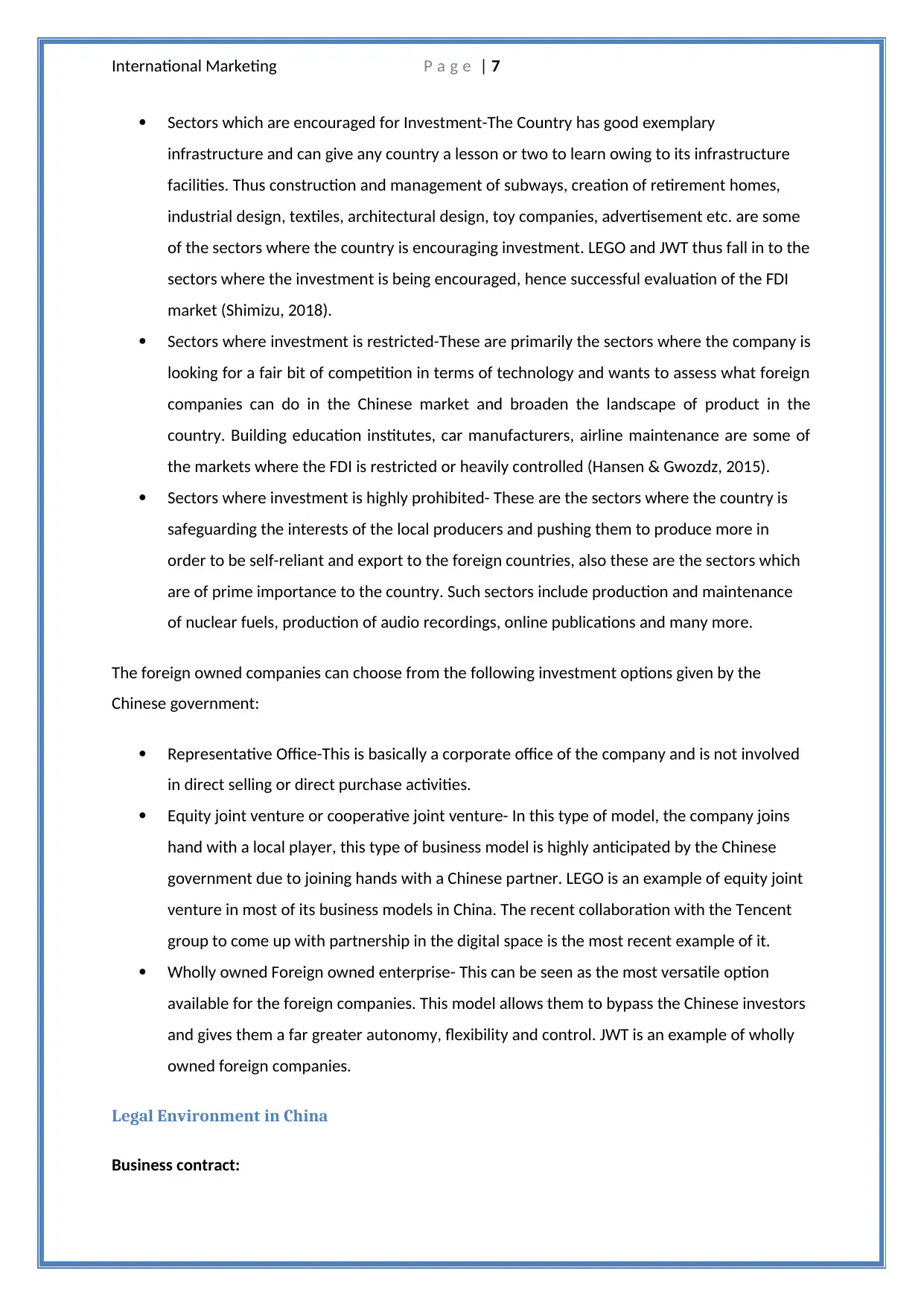
International Marketing P a g e | 7
Sectors which are encouraged for Investment-The Country has good exemplary
infrastructure and can give any country a lesson or two to learn owing to its infrastructure
facilities. Thus construction and management of subways, creation of retirement homes,
industrial design, textiles, architectural design, toy companies, advertisement etc. are some
of the sectors where the country is encouraging investment. LEGO and JWT thus fall in to the
sectors where the investment is being encouraged, hence successful evaluation of the FDI
market (Shimizu, 2018).
Sectors where investment is restricted-These are primarily the sectors where the company is
looking for a fair bit of competition in terms of technology and wants to assess what foreign
companies can do in the Chinese market and broaden the landscape of product in the
country. Building education institutes, car manufacturers, airline maintenance are some of
the markets where the FDI is restricted or heavily controlled (Hansen & Gwozdz, 2015).
Sectors where investment is highly prohibited- These are the sectors where the country is
safeguarding the interests of the local producers and pushing them to produce more in
order to be self-reliant and export to the foreign countries, also these are the sectors which
are of prime importance to the country. Such sectors include production and maintenance
of nuclear fuels, production of audio recordings, online publications and many more.
The foreign owned companies can choose from the following investment options given by the
Chinese government:
Representative Office-This is basically a corporate office of the company and is not involved
in direct selling or direct purchase activities.
Equity joint venture or cooperative joint venture- In this type of model, the company joins
hand with a local player, this type of business model is highly anticipated by the Chinese
government due to joining hands with a Chinese partner. LEGO is an example of equity joint
venture in most of its business models in China. The recent collaboration with the Tencent
group to come up with partnership in the digital space is the most recent example of it.
Wholly owned Foreign owned enterprise- This can be seen as the most versatile option
available for the foreign companies. This model allows them to bypass the Chinese investors
and gives them a far greater autonomy, flexibility and control. JWT is an example of wholly
owned foreign companies.
Legal Environment in China
Business contract:
Sectors which are encouraged for Investment-The Country has good exemplary
infrastructure and can give any country a lesson or two to learn owing to its infrastructure
facilities. Thus construction and management of subways, creation of retirement homes,
industrial design, textiles, architectural design, toy companies, advertisement etc. are some
of the sectors where the country is encouraging investment. LEGO and JWT thus fall in to the
sectors where the investment is being encouraged, hence successful evaluation of the FDI
market (Shimizu, 2018).
Sectors where investment is restricted-These are primarily the sectors where the company is
looking for a fair bit of competition in terms of technology and wants to assess what foreign
companies can do in the Chinese market and broaden the landscape of product in the
country. Building education institutes, car manufacturers, airline maintenance are some of
the markets where the FDI is restricted or heavily controlled (Hansen & Gwozdz, 2015).
Sectors where investment is highly prohibited- These are the sectors where the country is
safeguarding the interests of the local producers and pushing them to produce more in
order to be self-reliant and export to the foreign countries, also these are the sectors which
are of prime importance to the country. Such sectors include production and maintenance
of nuclear fuels, production of audio recordings, online publications and many more.
The foreign owned companies can choose from the following investment options given by the
Chinese government:
Representative Office-This is basically a corporate office of the company and is not involved
in direct selling or direct purchase activities.
Equity joint venture or cooperative joint venture- In this type of model, the company joins
hand with a local player, this type of business model is highly anticipated by the Chinese
government due to joining hands with a Chinese partner. LEGO is an example of equity joint
venture in most of its business models in China. The recent collaboration with the Tencent
group to come up with partnership in the digital space is the most recent example of it.
Wholly owned Foreign owned enterprise- This can be seen as the most versatile option
available for the foreign companies. This model allows them to bypass the Chinese investors
and gives them a far greater autonomy, flexibility and control. JWT is an example of wholly
owned foreign companies.
Legal Environment in China
Business contract:
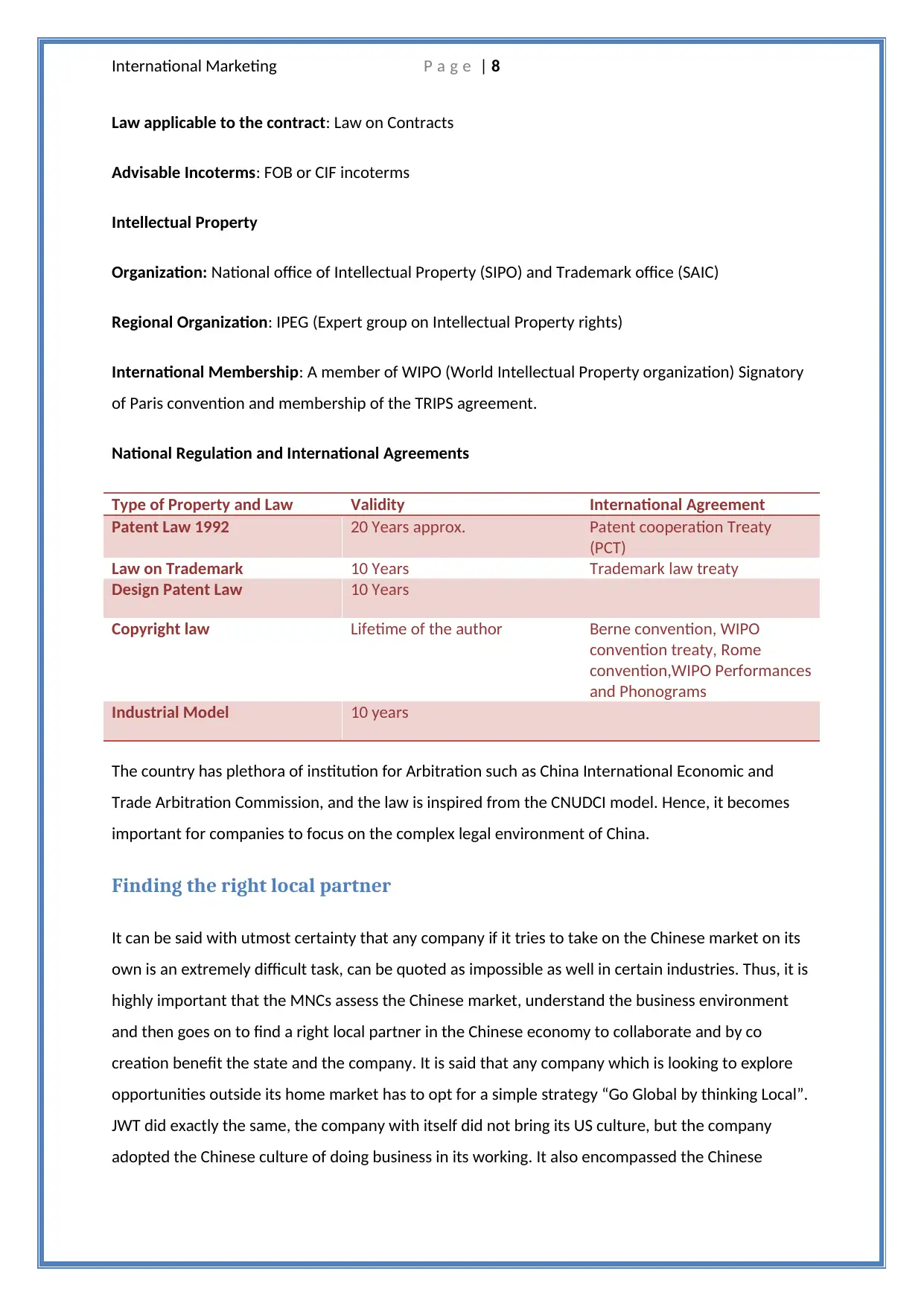
International Marketing P a g e | 8
Law applicable to the contract: Law on Contracts
Advisable Incoterms: FOB or CIF incoterms
Intellectual Property
Organization: National office of Intellectual Property (SIPO) and Trademark office (SAIC)
Regional Organization: IPEG (Expert group on Intellectual Property rights)
International Membership: A member of WIPO (World Intellectual Property organization) Signatory
of Paris convention and membership of the TRIPS agreement.
National Regulation and International Agreements
Type of Property and Law Validity International Agreement
Patent Law 1992 20 Years approx. Patent cooperation Treaty
(PCT)
Law on Trademark 10 Years Trademark law treaty
Design Patent Law 10 Years
Copyright law Lifetime of the author Berne convention, WIPO
convention treaty, Rome
convention,WIPO Performances
and Phonograms
Industrial Model 10 years
The country has plethora of institution for Arbitration such as China International Economic and
Trade Arbitration Commission, and the law is inspired from the CNUDCI model. Hence, it becomes
important for companies to focus on the complex legal environment of China.
Finding the right local partner
It can be said with utmost certainty that any company if it tries to take on the Chinese market on its
own is an extremely difficult task, can be quoted as impossible as well in certain industries. Thus, it is
highly important that the MNCs assess the Chinese market, understand the business environment
and then goes on to find a right local partner in the Chinese economy to collaborate and by co
creation benefit the state and the company. It is said that any company which is looking to explore
opportunities outside its home market has to opt for a simple strategy “Go Global by thinking Local”.
JWT did exactly the same, the company with itself did not bring its US culture, but the company
adopted the Chinese culture of doing business in its working. It also encompassed the Chinese
Law applicable to the contract: Law on Contracts
Advisable Incoterms: FOB or CIF incoterms
Intellectual Property
Organization: National office of Intellectual Property (SIPO) and Trademark office (SAIC)
Regional Organization: IPEG (Expert group on Intellectual Property rights)
International Membership: A member of WIPO (World Intellectual Property organization) Signatory
of Paris convention and membership of the TRIPS agreement.
National Regulation and International Agreements
Type of Property and Law Validity International Agreement
Patent Law 1992 20 Years approx. Patent cooperation Treaty
(PCT)
Law on Trademark 10 Years Trademark law treaty
Design Patent Law 10 Years
Copyright law Lifetime of the author Berne convention, WIPO
convention treaty, Rome
convention,WIPO Performances
and Phonograms
Industrial Model 10 years
The country has plethora of institution for Arbitration such as China International Economic and
Trade Arbitration Commission, and the law is inspired from the CNUDCI model. Hence, it becomes
important for companies to focus on the complex legal environment of China.
Finding the right local partner
It can be said with utmost certainty that any company if it tries to take on the Chinese market on its
own is an extremely difficult task, can be quoted as impossible as well in certain industries. Thus, it is
highly important that the MNCs assess the Chinese market, understand the business environment
and then goes on to find a right local partner in the Chinese economy to collaborate and by co
creation benefit the state and the company. It is said that any company which is looking to explore
opportunities outside its home market has to opt for a simple strategy “Go Global by thinking Local”.
JWT did exactly the same, the company with itself did not bring its US culture, but the company
adopted the Chinese culture of doing business in its working. It also encompassed the Chinese
⊘ This is a preview!⊘
Do you want full access?
Subscribe today to unlock all pages.

Trusted by 1+ million students worldwide
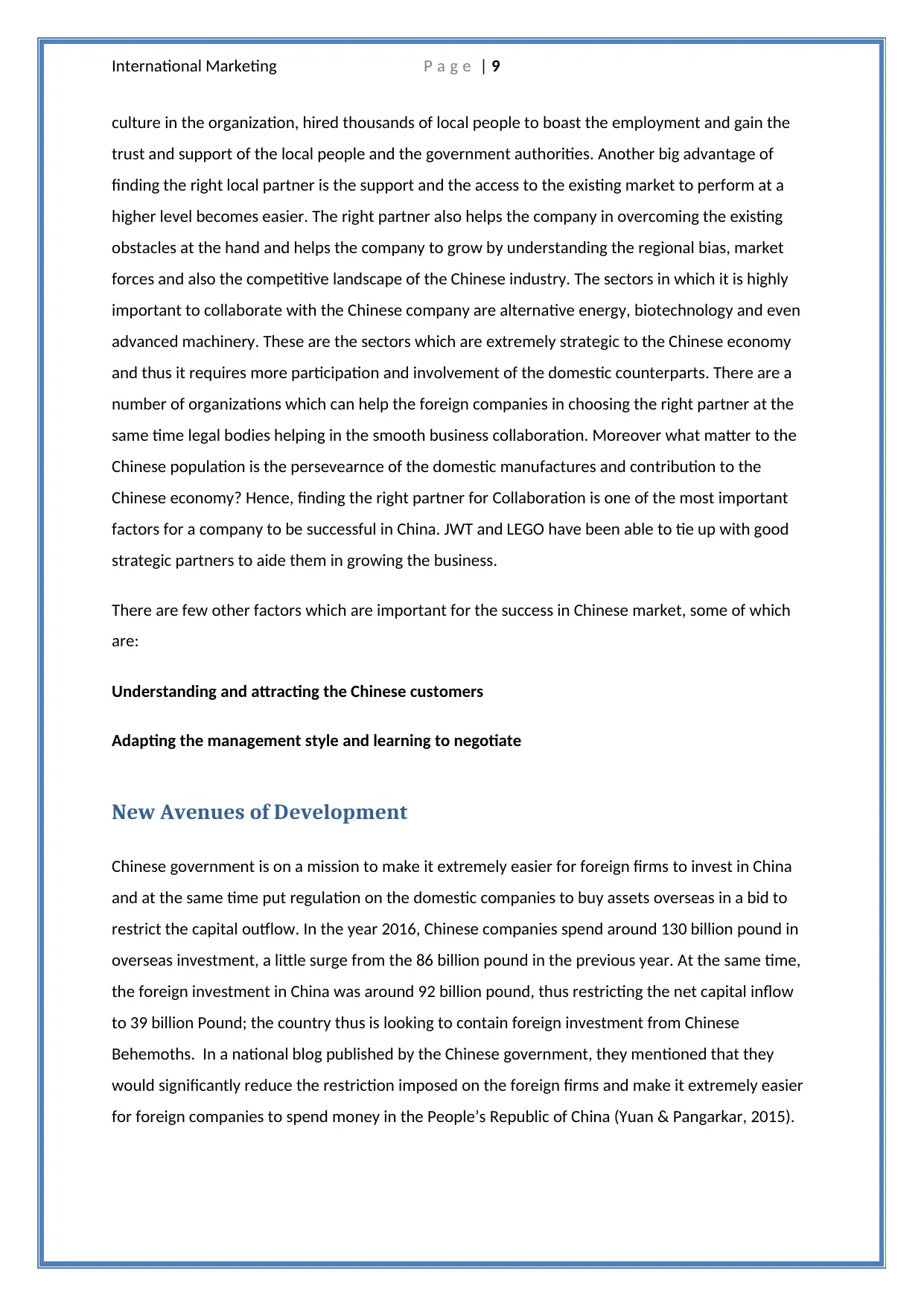
International Marketing P a g e | 9
culture in the organization, hired thousands of local people to boast the employment and gain the
trust and support of the local people and the government authorities. Another big advantage of
finding the right local partner is the support and the access to the existing market to perform at a
higher level becomes easier. The right partner also helps the company in overcoming the existing
obstacles at the hand and helps the company to grow by understanding the regional bias, market
forces and also the competitive landscape of the Chinese industry. The sectors in which it is highly
important to collaborate with the Chinese company are alternative energy, biotechnology and even
advanced machinery. These are the sectors which are extremely strategic to the Chinese economy
and thus it requires more participation and involvement of the domestic counterparts. There are a
number of organizations which can help the foreign companies in choosing the right partner at the
same time legal bodies helping in the smooth business collaboration. Moreover what matter to the
Chinese population is the persevearnce of the domestic manufactures and contribution to the
Chinese economy? Hence, finding the right partner for Collaboration is one of the most important
factors for a company to be successful in China. JWT and LEGO have been able to tie up with good
strategic partners to aide them in growing the business.
There are few other factors which are important for the success in Chinese market, some of which
are:
Understanding and attracting the Chinese customers
Adapting the management style and learning to negotiate
New Avenues of Development
Chinese government is on a mission to make it extremely easier for foreign firms to invest in China
and at the same time put regulation on the domestic companies to buy assets overseas in a bid to
restrict the capital outflow. In the year 2016, Chinese companies spend around 130 billion pound in
overseas investment, a little surge from the 86 billion pound in the previous year. At the same time,
the foreign investment in China was around 92 billion pound, thus restricting the net capital inflow
to 39 billion Pound; the country thus is looking to contain foreign investment from Chinese
Behemoths. In a national blog published by the Chinese government, they mentioned that they
would significantly reduce the restriction imposed on the foreign firms and make it extremely easier
for foreign companies to spend money in the People’s Republic of China (Yuan & Pangarkar, 2015).
culture in the organization, hired thousands of local people to boast the employment and gain the
trust and support of the local people and the government authorities. Another big advantage of
finding the right local partner is the support and the access to the existing market to perform at a
higher level becomes easier. The right partner also helps the company in overcoming the existing
obstacles at the hand and helps the company to grow by understanding the regional bias, market
forces and also the competitive landscape of the Chinese industry. The sectors in which it is highly
important to collaborate with the Chinese company are alternative energy, biotechnology and even
advanced machinery. These are the sectors which are extremely strategic to the Chinese economy
and thus it requires more participation and involvement of the domestic counterparts. There are a
number of organizations which can help the foreign companies in choosing the right partner at the
same time legal bodies helping in the smooth business collaboration. Moreover what matter to the
Chinese population is the persevearnce of the domestic manufactures and contribution to the
Chinese economy? Hence, finding the right partner for Collaboration is one of the most important
factors for a company to be successful in China. JWT and LEGO have been able to tie up with good
strategic partners to aide them in growing the business.
There are few other factors which are important for the success in Chinese market, some of which
are:
Understanding and attracting the Chinese customers
Adapting the management style and learning to negotiate
New Avenues of Development
Chinese government is on a mission to make it extremely easier for foreign firms to invest in China
and at the same time put regulation on the domestic companies to buy assets overseas in a bid to
restrict the capital outflow. In the year 2016, Chinese companies spend around 130 billion pound in
overseas investment, a little surge from the 86 billion pound in the previous year. At the same time,
the foreign investment in China was around 92 billion pound, thus restricting the net capital inflow
to 39 billion Pound; the country thus is looking to contain foreign investment from Chinese
Behemoths. In a national blog published by the Chinese government, they mentioned that they
would significantly reduce the restriction imposed on the foreign firms and make it extremely easier
for foreign companies to spend money in the People’s Republic of China (Yuan & Pangarkar, 2015).
Paraphrase This Document
Need a fresh take? Get an instant paraphrase of this document with our AI Paraphraser
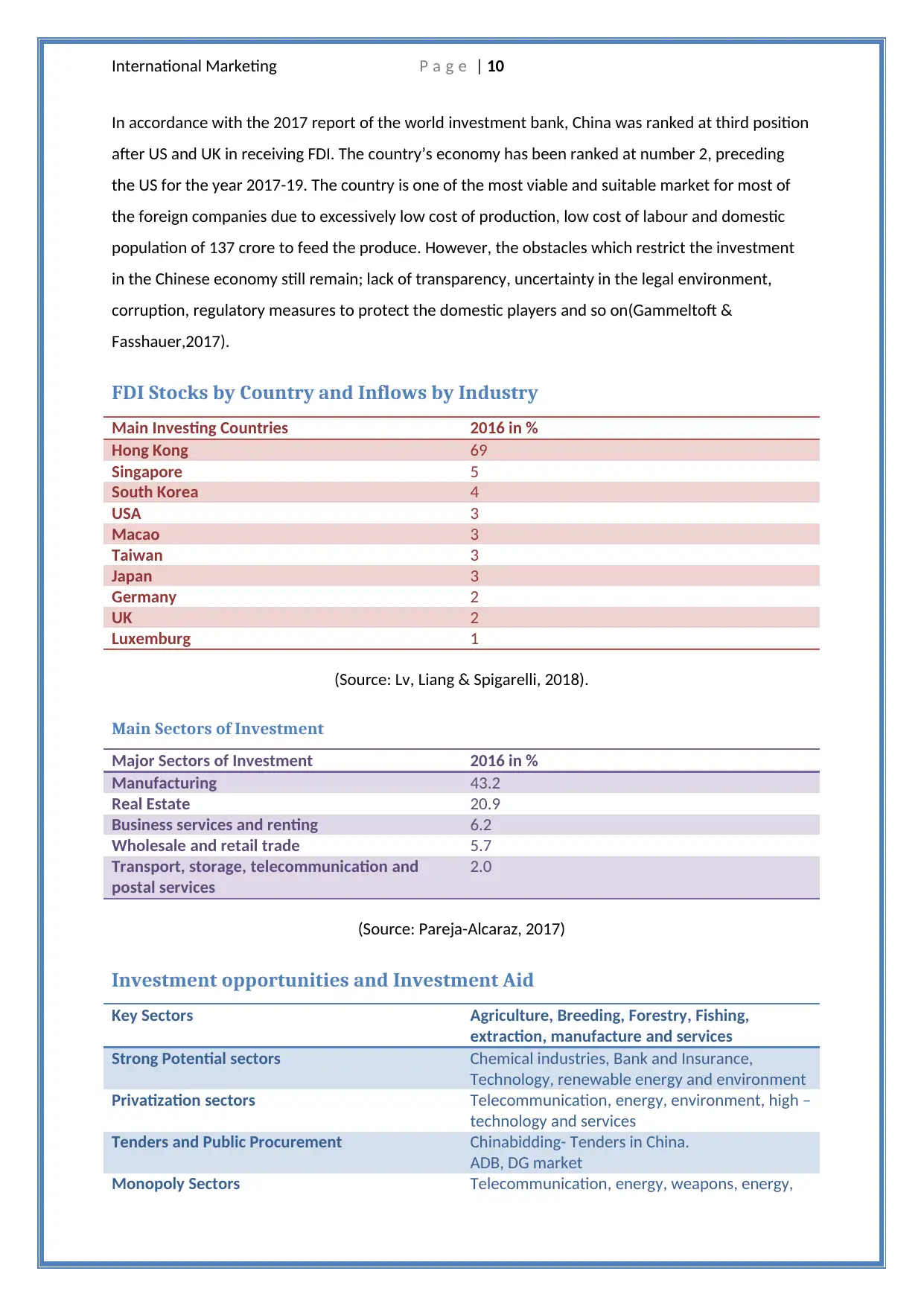
International Marketing P a g e | 10
In accordance with the 2017 report of the world investment bank, China was ranked at third position
after US and UK in receiving FDI. The country’s economy has been ranked at number 2, preceding
the US for the year 2017-19. The country is one of the most viable and suitable market for most of
the foreign companies due to excessively low cost of production, low cost of labour and domestic
population of 137 crore to feed the produce. However, the obstacles which restrict the investment
in the Chinese economy still remain; lack of transparency, uncertainty in the legal environment,
corruption, regulatory measures to protect the domestic players and so on(Gammeltoft &
Fasshauer,2017).
FDI Stocks by Country and Inflows by Industry
Main Investing Countries 2016 in %
Hong Kong 69
Singapore 5
South Korea 4
USA 3
Macao 3
Taiwan 3
Japan 3
Germany 2
UK 2
Luxemburg 1
(Source: Lv, Liang & Spigarelli, 2018).
Main Sectors of Investment
Major Sectors of Investment 2016 in %
Manufacturing 43.2
Real Estate 20.9
Business services and renting 6.2
Wholesale and retail trade 5.7
Transport, storage, telecommunication and
postal services
2.0
(Source: Pareja-Alcaraz, 2017)
Investment opportunities and Investment Aid
Key Sectors Agriculture, Breeding, Forestry, Fishing,
extraction, manufacture and services
Strong Potential sectors Chemical industries, Bank and Insurance,
Technology, renewable energy and environment
Privatization sectors Telecommunication, energy, environment, high –
technology and services
Tenders and Public Procurement Chinabidding- Tenders in China.
ADB, DG market
Monopoly Sectors Telecommunication, energy, weapons, energy,
In accordance with the 2017 report of the world investment bank, China was ranked at third position
after US and UK in receiving FDI. The country’s economy has been ranked at number 2, preceding
the US for the year 2017-19. The country is one of the most viable and suitable market for most of
the foreign companies due to excessively low cost of production, low cost of labour and domestic
population of 137 crore to feed the produce. However, the obstacles which restrict the investment
in the Chinese economy still remain; lack of transparency, uncertainty in the legal environment,
corruption, regulatory measures to protect the domestic players and so on(Gammeltoft &
Fasshauer,2017).
FDI Stocks by Country and Inflows by Industry
Main Investing Countries 2016 in %
Hong Kong 69
Singapore 5
South Korea 4
USA 3
Macao 3
Taiwan 3
Japan 3
Germany 2
UK 2
Luxemburg 1
(Source: Lv, Liang & Spigarelli, 2018).
Main Sectors of Investment
Major Sectors of Investment 2016 in %
Manufacturing 43.2
Real Estate 20.9
Business services and renting 6.2
Wholesale and retail trade 5.7
Transport, storage, telecommunication and
postal services
2.0
(Source: Pareja-Alcaraz, 2017)
Investment opportunities and Investment Aid
Key Sectors Agriculture, Breeding, Forestry, Fishing,
extraction, manufacture and services
Strong Potential sectors Chemical industries, Bank and Insurance,
Technology, renewable energy and environment
Privatization sectors Telecommunication, energy, environment, high –
technology and services
Tenders and Public Procurement Chinabidding- Tenders in China.
ADB, DG market
Monopoly Sectors Telecommunication, energy, weapons, energy,
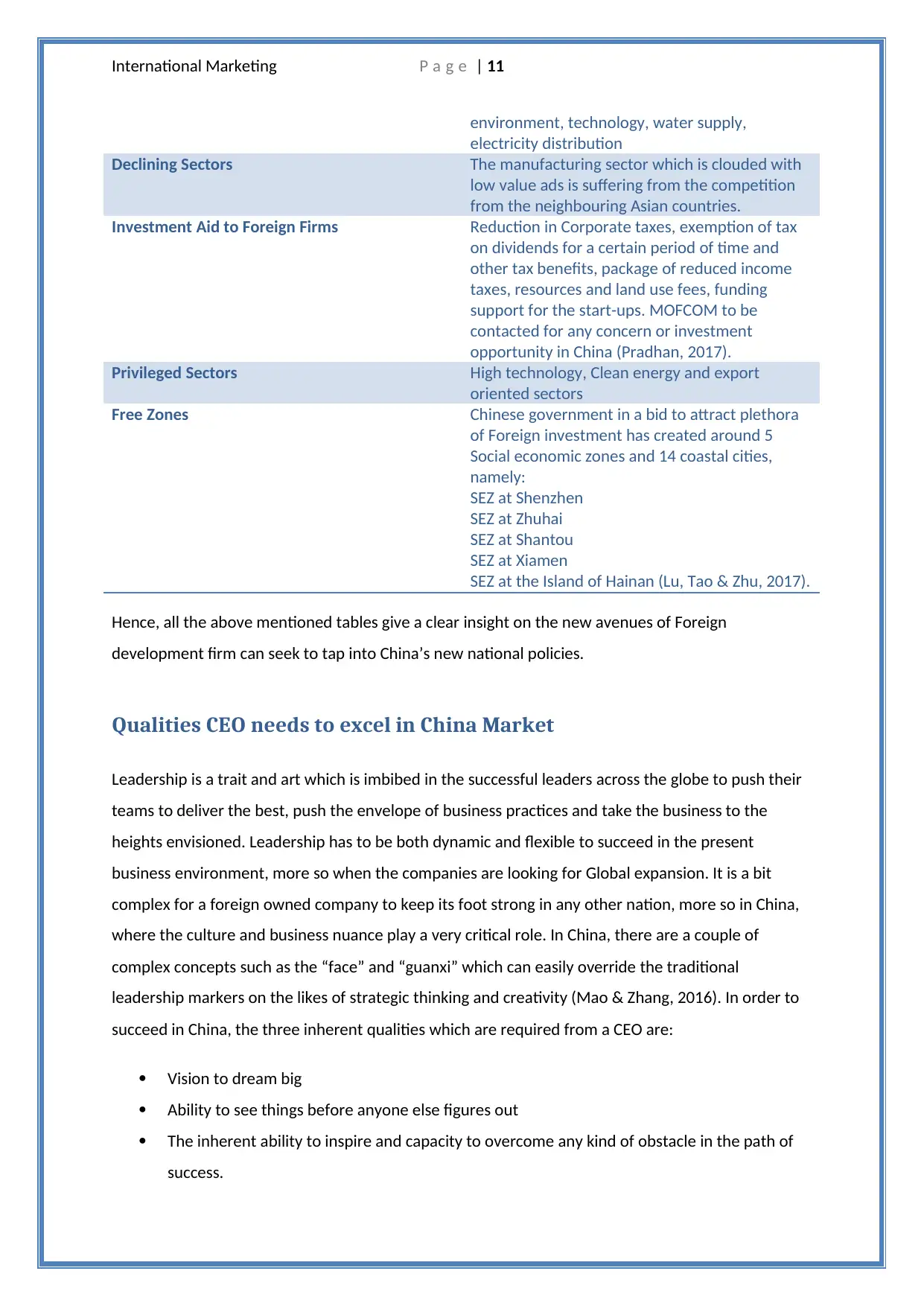
International Marketing P a g e | 11
environment, technology, water supply,
electricity distribution
Declining Sectors The manufacturing sector which is clouded with
low value ads is suffering from the competition
from the neighbouring Asian countries.
Investment Aid to Foreign Firms Reduction in Corporate taxes, exemption of tax
on dividends for a certain period of time and
other tax benefits, package of reduced income
taxes, resources and land use fees, funding
support for the start-ups. MOFCOM to be
contacted for any concern or investment
opportunity in China (Pradhan, 2017).
Privileged Sectors High technology, Clean energy and export
oriented sectors
Free Zones Chinese government in a bid to attract plethora
of Foreign investment has created around 5
Social economic zones and 14 coastal cities,
namely:
SEZ at Shenzhen
SEZ at Zhuhai
SEZ at Shantou
SEZ at Xiamen
SEZ at the Island of Hainan (Lu, Tao & Zhu, 2017).
Hence, all the above mentioned tables give a clear insight on the new avenues of Foreign
development firm can seek to tap into China’s new national policies.
Qualities CEO needs to excel in China Market
Leadership is a trait and art which is imbibed in the successful leaders across the globe to push their
teams to deliver the best, push the envelope of business practices and take the business to the
heights envisioned. Leadership has to be both dynamic and flexible to succeed in the present
business environment, more so when the companies are looking for Global expansion. It is a bit
complex for a foreign owned company to keep its foot strong in any other nation, more so in China,
where the culture and business nuance play a very critical role. In China, there are a couple of
complex concepts such as the “face” and “guanxi” which can easily override the traditional
leadership markers on the likes of strategic thinking and creativity (Mao & Zhang, 2016). In order to
succeed in China, the three inherent qualities which are required from a CEO are:
Vision to dream big
Ability to see things before anyone else figures out
The inherent ability to inspire and capacity to overcome any kind of obstacle in the path of
success.
environment, technology, water supply,
electricity distribution
Declining Sectors The manufacturing sector which is clouded with
low value ads is suffering from the competition
from the neighbouring Asian countries.
Investment Aid to Foreign Firms Reduction in Corporate taxes, exemption of tax
on dividends for a certain period of time and
other tax benefits, package of reduced income
taxes, resources and land use fees, funding
support for the start-ups. MOFCOM to be
contacted for any concern or investment
opportunity in China (Pradhan, 2017).
Privileged Sectors High technology, Clean energy and export
oriented sectors
Free Zones Chinese government in a bid to attract plethora
of Foreign investment has created around 5
Social economic zones and 14 coastal cities,
namely:
SEZ at Shenzhen
SEZ at Zhuhai
SEZ at Shantou
SEZ at Xiamen
SEZ at the Island of Hainan (Lu, Tao & Zhu, 2017).
Hence, all the above mentioned tables give a clear insight on the new avenues of Foreign
development firm can seek to tap into China’s new national policies.
Qualities CEO needs to excel in China Market
Leadership is a trait and art which is imbibed in the successful leaders across the globe to push their
teams to deliver the best, push the envelope of business practices and take the business to the
heights envisioned. Leadership has to be both dynamic and flexible to succeed in the present
business environment, more so when the companies are looking for Global expansion. It is a bit
complex for a foreign owned company to keep its foot strong in any other nation, more so in China,
where the culture and business nuance play a very critical role. In China, there are a couple of
complex concepts such as the “face” and “guanxi” which can easily override the traditional
leadership markers on the likes of strategic thinking and creativity (Mao & Zhang, 2016). In order to
succeed in China, the three inherent qualities which are required from a CEO are:
Vision to dream big
Ability to see things before anyone else figures out
The inherent ability to inspire and capacity to overcome any kind of obstacle in the path of
success.
⊘ This is a preview!⊘
Do you want full access?
Subscribe today to unlock all pages.

Trusted by 1+ million students worldwide
1 out of 17
Related Documents
Your All-in-One AI-Powered Toolkit for Academic Success.
+13062052269
info@desklib.com
Available 24*7 on WhatsApp / Email
![[object Object]](/_next/static/media/star-bottom.7253800d.svg)
Unlock your academic potential
Copyright © 2020–2025 A2Z Services. All Rights Reserved. Developed and managed by ZUCOL.





